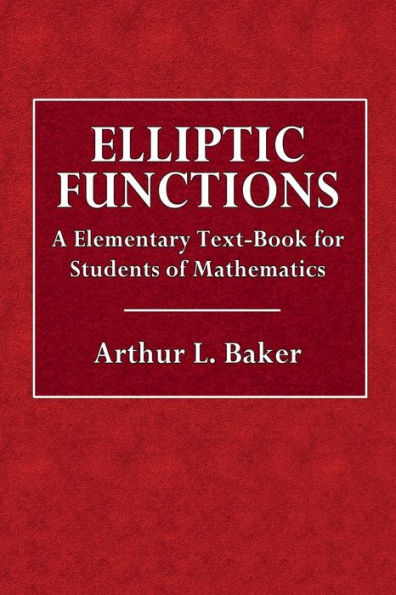Elliptic Functions
From the INTRODUCTORY CHAPTER. The first step taken in the theory of Elliptic Functions was the determination of a relation between the amplitudes of three functions of either order, such that there should exist an algebraic relation between the three functions themselves of which these were the amplitudes. It is one of the most remarkable discoveries which science owes to Euler. In 1761 he gave to the world the complete integration of an equation of two terms, each an elliptic function of the first or second order, not separately integrable. This integration introduced an arbitrary constant in the form of a third function, related to the first two by a given equation between the amplitudes of the three. In 1775 Landen, an English mathematician, published his celebrated theorem showing that any arc of a hyperbola may be measured by two arcs of an ellipse, an important element of the theory of Elliptic Functions, but then an isolated result. The great problem of comparison of Elliptic Functions of different moduli remained unsolved, though Euler, in a measure, exhausted the comparison of functions of the same modulus. It was completed in 1784 by Lagrange, and for the computation of numerical results leaves little to be desired. The value of a function may be determined by it, in terms of increasing or diminishing moduli, until at length it depends upon a function having a modulus of zero, or unity.
1021666754
Elliptic Functions
From the INTRODUCTORY CHAPTER. The first step taken in the theory of Elliptic Functions was the determination of a relation between the amplitudes of three functions of either order, such that there should exist an algebraic relation between the three functions themselves of which these were the amplitudes. It is one of the most remarkable discoveries which science owes to Euler. In 1761 he gave to the world the complete integration of an equation of two terms, each an elliptic function of the first or second order, not separately integrable. This integration introduced an arbitrary constant in the form of a third function, related to the first two by a given equation between the amplitudes of the three. In 1775 Landen, an English mathematician, published his celebrated theorem showing that any arc of a hyperbola may be measured by two arcs of an ellipse, an important element of the theory of Elliptic Functions, but then an isolated result. The great problem of comparison of Elliptic Functions of different moduli remained unsolved, though Euler, in a measure, exhausted the comparison of functions of the same modulus. It was completed in 1784 by Lagrange, and for the computation of numerical results leaves little to be desired. The value of a function may be determined by it, in terms of increasing or diminishing moduli, until at length it depends upon a function having a modulus of zero, or unity.
7.99
In Stock
5
1

Elliptic Functions
126
Elliptic Functions
126Paperback
$7.99
7.99
In Stock

Product Details
| ISBN-13: | 9781663529572 |
|---|---|
| Publisher: | Barnes & Noble Press |
| Publication date: | 07/10/2020 |
| Pages: | 126 |
| Product dimensions: | 6.00(w) x 9.00(h) x 0.30(d) |
From the B&N Reads Blog
